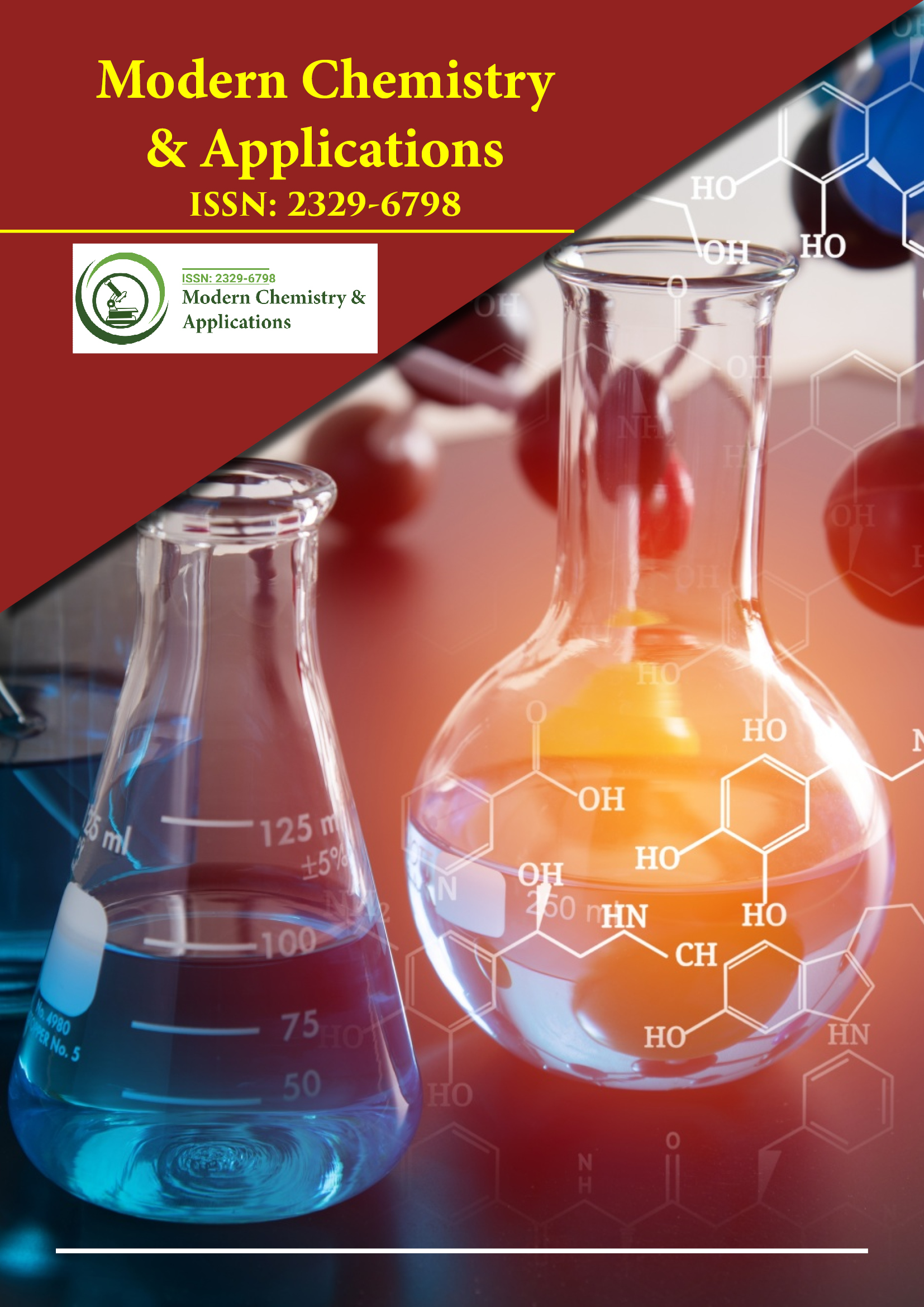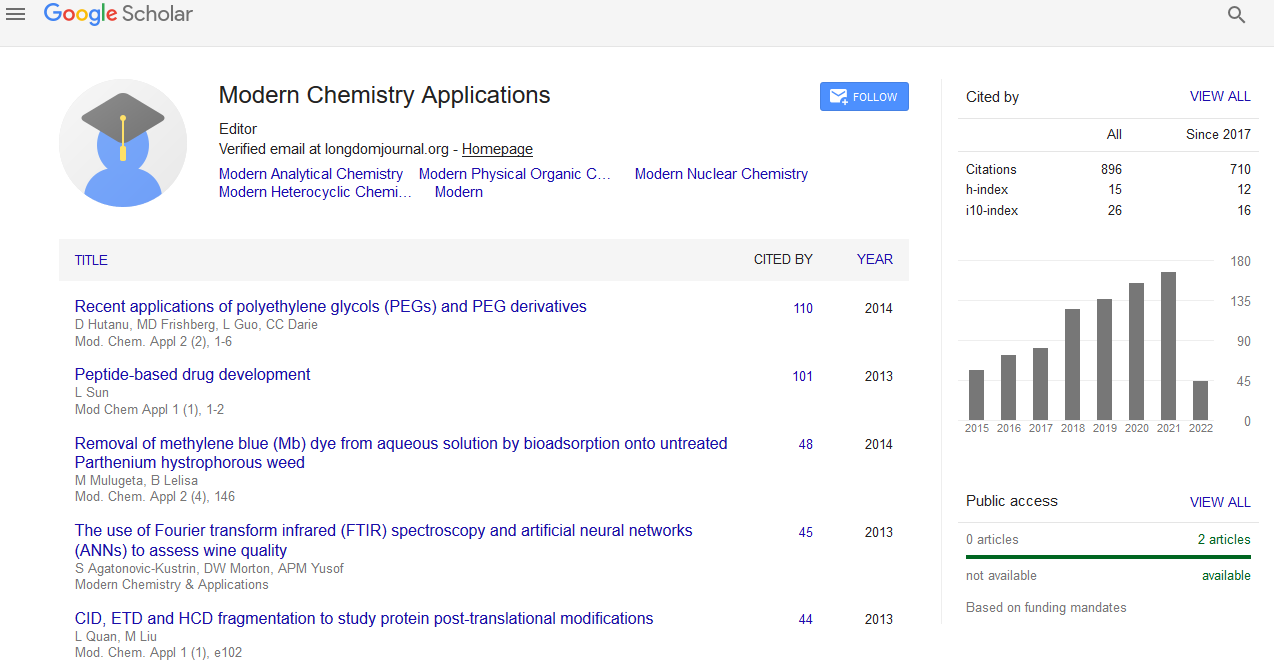Indexed In
- Open J Gate
- JournalTOCs
- RefSeek
- Hamdard University
- EBSCO A-Z
- OCLC- WorldCat
- Scholarsteer
- Publons
- Geneva Foundation for Medical Education and Research
- Google Scholar
Useful Links
Share This Page
Journal Flyer

Open Access Journals
- Agri and Aquaculture
- Biochemistry
- Bioinformatics & Systems Biology
- Business & Management
- Chemistry
- Clinical Sciences
- Engineering
- Food & Nutrition
- General Science
- Genetics & Molecular Biology
- Immunology & Microbiology
- Medical Sciences
- Neuroscience & Psychology
- Nursing & Health Care
- Pharmaceutical Sciences
Perspective - (2025) Volume 13, Issue 1
Synthesis and Analysis of Bioinspired Molecules with Therapeutic and Catalytic Potential
Yuki Tanabe*Received: 26-Feb-2025, Manuscript No. MCA-25-29057; Editor assigned: 28-Feb-2025, Pre QC No. MCA-25-29057 (PQ); Reviewed: 14-Mar-2025, QC No. MCA-25-29057; Revised: 21-Mar-2025, Manuscript No. MCA-25-29057 (R); Published: 28-Mar-2025, DOI: 10.35248/2157-7560.25.13.487
Description
The development of bioinspired molecules has become an important focus in chemistry due to their structural similarity to compounds found in nature and their wide range of applications. These molecules, designed to mimic biological systems, offer functional properties that are useful in medicine and catalysis. By studying how nature builds and operates molecular frameworks, chemists are creating synthetic systems that replicate or adapt these features for controlled use.
In the pharmaceutical field, researchers often look to nature for molecular patterns that have biological activity. Many natural products compounds isolated from plants, bacteria, fungi, or marine organisms serve as templates for drug development. These structures often display strong binding capabilities, unique shapes and functional groups that interact specifically with biological targets. Once a compound of interest is identified, synthetic efforts focus on producing it in the laboratory, either by duplicating the natural pathway or developing shorter, more efficient methods.
The synthesis of such molecules often involves complex steps that require careful control of chemical reactions. Techniques like stereoselective synthesis, protecting group strategies and advanced catalysis are used to build molecules with the correct spatial orientation and functionality. Some synthetic routes aim to replicate the natural biosynthesis, while others modify the structure to improve stability, activity, or solubility. These changes are important for improving performance in biological systems and ensuring the compound can be manufactured consistently.
In addition to medical applications, bioinspired molecules are being designed for use as catalysts. Enzymes, which are natural catalysts, serve as models for creating synthetic versions that perform similar transformations under laboratory or industrial conditions. These synthetic catalysts can be more stable, easier to produce, or tunable for specific reactions. Some mimic the active sites of enzymes, while others reproduce the general environment needed for catalysis, such as metal centers surrounded by specific ligands.
Metal-organic frameworks, peptidomimetics and small organic molecules are examples of synthetic structures developed with inspiration from biology. These compounds can activate small molecules, accelerate bond-forming reactions, or break down pollutants. Their efficiency depends on their structure, which determines how well they bind substrates and lower energy barriers for reactions. Research continues to focus on designing systems that work under mild conditions, have high selectivity and require minimal energy input.
Analytical techniques play a key role in confirming the structure and behavior of these synthetic compounds. Methods like Nuclear Magnetic Resonance (NMR), infrared spectroscopy, mass spectrometry and X-ray crystallography provide information on molecular geometry, composition and bonding. These tools are essential for verifying that the desired compound has been produced and for studying how it interacts with biological targets or participates in catalytic cycles.
In biological testing, researchers evaluate the activity of synthetic compounds using in vitro assays, cell cultures and sometimes animal models. These tests measure properties such as binding affinity, toxicity, stability in biological fluids and metabolic pathways. The results guide further optimization, as compounds are often modified to improve their interaction with a specific target or to reduce unwanted effects. Selectivity is a key factor, as it determines how well a compound acts on its intended target without affecting others.
In catalysis, performance is often measured by turnover frequency, product yield and selectivity. Recyclability and stability over multiple reaction cycles are also important. If a catalyst can function in water or under ambient conditions, it is more suitable for green chemistry applications. Researchers are exploring how to make catalytic systems that are self-healing or can adjust to different conditions, much like natural enzymes do in living systems.
Environmental and economic factors are also influencing how bioinspired molecules are developed. There is growing interest in using renewable feedstocks, reducing waste and designing processes that avoid hazardous reagents. Shorter synthesis routes, high atom economy and mild reaction conditions are preferred. These considerations align with wider goals in sustainable chemistry and industrial efficiency.
By studying nature’s solutions and combining that knowledge with chemical design, scientists are expanding the possibilities for functional molecules in health and industry. As methods improve and understanding deepens, the creation and application of these compounds will likely continue to play a significant role in innovation across many sectors.
Citation: Tanabe Y (2025). Synthesis and Analysis of Bioinspired Molecules with Therapeutic and Catalytic Potential. Modern Chem Appl. 13:487.
Copyright: © 2025 Tanabe Y. This is an open access article distributed under the terms of the Creative Commons Attribution License, which permits unrestricted use, distribution and reproduction in any medium, provided the original author and source are credited.


